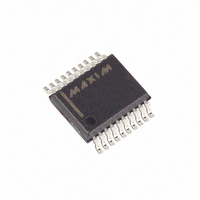MAX148BCAP+ Maxim Integrated Products, MAX148BCAP+ Datasheet - Page 10

MAX148BCAP+
Manufacturer Part Number
MAX148BCAP+
Description
IC ADC SRL 8CH 10BIT LP 20-SSOP
Manufacturer
Maxim Integrated Products
Datasheet
1.MAX148BCAP.pdf
(23 pages)
Specifications of MAX148BCAP+
Number Of Bits
10
Sampling Rate (per Second)
133k
Data Interface
MICROWIRE™, QSPI™, Serial, SPI™
Number Of Converters
1
Power Dissipation (max)
640mW
Voltage Supply Source
Single Supply
Operating Temperature
0°C ~ 70°C
Mounting Type
Surface Mount
Package / Case
20-SSOP
Number Of Adc Inputs
8
Architecture
SAR
Conversion Rate
133 KSPs
Resolution
10 bit
Input Type
Voltage
Interface Type
4-Wire (SPI, QSPI, MICROWIRE, TMS320)
Voltage Reference
Internal 2.5 V or External
Supply Voltage (max)
5 V
Maximum Power Dissipation
640 mW
Maximum Operating Temperature
+ 70 C
Mounting Style
SMD/SMT
Minimum Operating Temperature
0 C
Lead Free Status / RoHS Status
Lead free / RoHS Compliant
+2.7V to +5.25V, Low-Power, 8-Channel,
Serial 10-Bit ADCs
Table 1. Control-Byte Format
Table 2. Channel Selection in Single-Ended Mode (SGL/DIF = 1)
Start a conversion by clocking a control byte into DIN.
With CS low, each rising edge on SCLK clocks a bit from
DIN into the MAX148/MAX149’s internal shift register.
After CS falls, the first arriving logic “1” bit defines the
control byte’s MSB. Until this first “start” bit arrives, any
number of logic “0” bits can be clocked into DIN with no
effect. Table 1 shows the control-byte format.
The MAX148/MAX149 are compatible with SPI/QSPI and
MICROWIRE devices. For SPI, select the correct clock
10
SEL2
7(MSB)
START
0(LSB)
0
1
0
1
0
1
0
1
(MSB)
BIT 7
_____________________________________________________________________________________
BIT
6
5
4
3
2
1
SEL1
0
0
0
0
1
1
1
1
SGL/DIF
UNI/BIP
START
NAME
BIT 6
SEL2
SEL2
SEL1
SEL0
PD1
PD0
SEL0
How to Start a Conversion
0
0
1
1
0
0
1
1
The first logic “1” bit after CS goes low defines the beginning of the control byte.
These three bits select which of the eight channels are used for the conversion (Tables 2 and 3)
1 = unipolar, 0 = bipolar. Selects unipolar or bipolar conversion mode. In unipolar mode, an
analog input signal from 0 to VREF can be converted; in bipolar mode, the signal can range from
-VREF/2 to +VREF/2.
1 = single ended, 0 = differential. Selects single-ended or differential conversions. In single-
ended mode, input signal voltages are referred to COM. In differential mode, the voltage
difference between two channels is measured (Tables 2 and 3).
Selects clock and power-down modes.
CH0
+
PD1
BIT 5
SEL1
0
0
1
1
CH1
+
PD0
0
1
0
1
BIT 4
SEL0
CH2
+
Mode
Full power-down
Fast power-down (MAX149 only)
Internal clock mode
External clock mode
CH3
polarity and sampling edge in the SPI control registers:
set CPOL = 0 and CPHA = 0. MICROWIRE, SPI, and
QSPI all transmit a byte and receive a byte at the same
time. Using the Typical Operating Circuit, the simplest
software interface requires only three 8-bit transfers to
perform a conversion (one 8-bit transfer to configure
the ADC, and two more 8-bit transfers to clock out the
conversion result). See Figure 20 for MAX148/ MAX149
QSPI connections.
+
UNI/BIP
BIT 3
DESCRIPTION
CH4
+
SGL//DIF
BIT 2
CH5
+
CH6
+
BIT 1
PD1
CH7
+
(LSB)
BIT 0
PD0
COM
-
-
-
-
-
-
-
-











